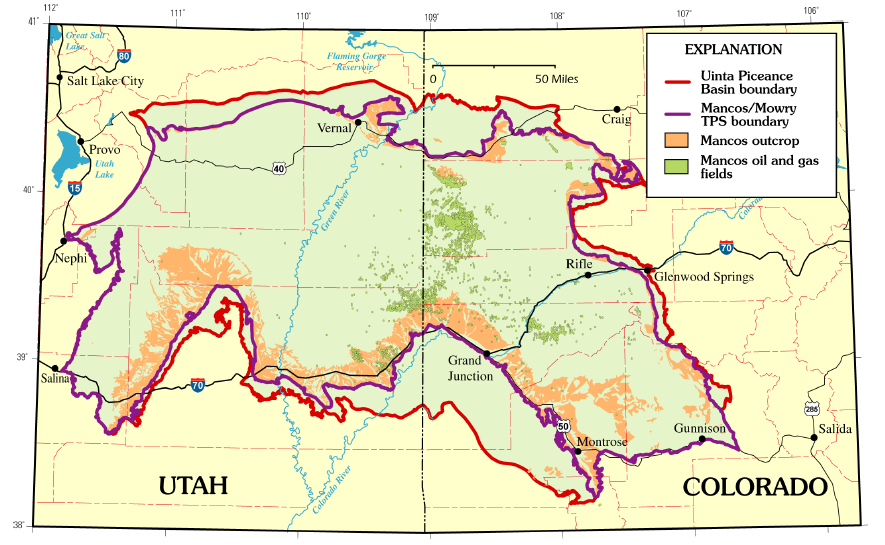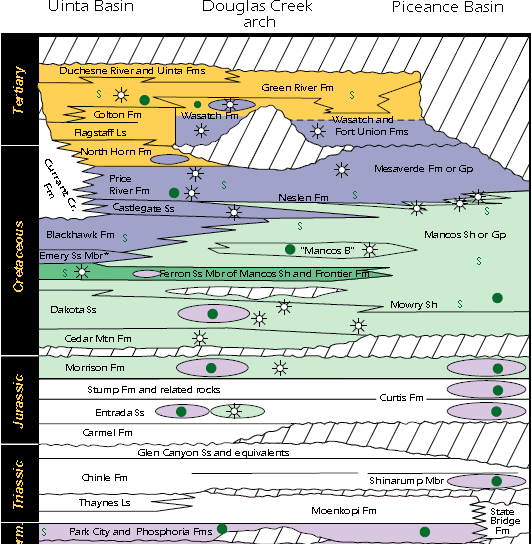Mancos Shale on:
[Wikipedia]
[Google]
[Amazon]



 The Mancos Shale or Mancos Group is a
The Mancos Shale or Mancos Group is a
United States Geological Survey The subunits and intertonguing formations (in italics) in each basin, in stratigraphic order, are:



 The Mancos Shale or Mancos Group is a
The Mancos Shale or Mancos Group is a Late Cretaceous
The Late Cretaceous (100.5–66 Ma) is the younger of two epochs into which the Cretaceous Period is divided in the geologic time scale. Rock strata from this epoch form the Upper Cretaceous Series. The Cretaceous is named after ''creta'', ...
(Upper Cretaceous) geologic formation
A geological formation, or simply formation, is a body of rock having a consistent set of physical characteristics (lithology) that distinguishes it from adjacent bodies of rock, and which occupies a particular position in the layers of rock expo ...
of the Western United States
The Western United States (also called the American West, the Far West, and the West) is the region comprising the westernmost states of the United States. As American settlement in the U.S. expanded westward, the meaning of the term ''the We ...
.
The Mancos Shale was first described by Cross and Purington in 1899 and was named for exposures near the town of Mancos, Colorado
Mancos is a statutory town in Montezuma County, Colorado, United States. The population was 1,196 at the 2020 census, down from 1,336 in 2010.
The town is in southwestern Colorado, at the base of Mesa Verde National Park, and holds the tradema ...
.
Geology
The unit is dominated bymudrock
Mudrocks are a class of fine-grained siliciclastic sedimentary rocks. The varying types of mudrocks include siltstone, claystone, mudstone, slate, and shale. Most of the particles of which the stone is composed are less than and are too ...
that accumulated in offshore and marine environments of the Cretaceous North American Inland Sea. The Mancos was deposited during the Cenomanian
The Cenomanian is, in the ICS' geological timescale, the oldest or earliest age of the Late Cretaceous Epoch or the lowest stage of the Upper Cretaceous Series. An age is a unit of geochronology; it is a unit of time; the stage is a unit in ...
(locally Albian
The Albian is both an age of the geologic timescale and a stage in the stratigraphic column. It is the youngest or uppermost subdivision of the Early/Lower Cretaceous Epoch/ Series. Its approximate time range is 113.0 ± 1.0 Ma to 100.5 ± 0 ...
) through Campanian
The Campanian is the fifth of six ages of the Late Cretaceous Epoch on the geologic timescale of the International Commission on Stratigraphy (ICS). In chronostratigraphy, it is the fifth of six stages in the Upper Cretaceous Series. Campani ...
ages Ages may refer to:
*Advanced glycation end-products, known as AGEs
*Ages, Kentucky, census-designated place, United States
* ''Ages'' (album) by German electronic musician Edgar Froese
*The geologic time scale, a system of chronological measuremen ...
, approximately from 95 million years ago ( Ma) to 80 Ma.
Stratigraphically the Mancos Shale fills the interval between the Dakota and the Mesaverde Group.
The lower marine Mancos Shale conformably intertongues with terrestrial sandstone
Sandstone is a clastic sedimentary rock composed mainly of sand-sized (0.0625 to 2 mm) silicate grains. Sandstones comprise about 20–25% of all sedimentary rocks.
Most sandstone is composed of quartz or feldspar (both silicat ...
s and mudstones of the Dakota and in its upper part grades into and intertongues with the Mesaverde Group. The shale tongues typically have sharp basal contacts and gradational upper contacts. Whereas in the plains east of the Rocky Mountains certain mappable marine shales are identified as formations (e.g., Skull Creek, Graneros
Graneros is a Chilean commune and city in Cachapoal Province, O'Higgins Region.
Deportes
Graneros se conoce como unas de las candidatas a ganar la copa de la región Libertador Bernardo Ohiggins
Tiene su Estadio renovado,El Estadio Miguel Riffo ...
), correlated deposits within the distribution of the Mancos are named as tongues of the greater Mancos Formation.
Thus, the classification broadly corresponds with the Colorado Group
Colorado is a geologic name applied to certain rocks of Cretaceous age in the North America, particularly in the western Great Plains. This name was originally applied to classify a group of specific marine formations of shale and chalk k ...
classification of the Great Plains
The Great Plains (french: Grandes Plaines), sometimes simply "the Plains", is a broad expanse of flatland in North America. It is located west of the Mississippi River and east of the Rocky Mountains, much of it covered in prairie, steppe, a ...
region. As such, various units of the Colorado Group are recognized within the Mancos in those areas where their distinct facies can be recognized.
Occurrences
The Mancos occurs in theBasin and Range Province
The Basin and Range Province is a vast physiographic region covering much of the inland Western United States and northwestern Mexico. It is defined by unique basin and range topography, characterized by abrupt changes in elevation, alternating ...
, the Colorado Plateau Province, and the San Juan Mountains Province.
Structural basins
The Mancos is a diverse unit, with dozens of named subunits in differentstructural basin
A structural basin is a large-scale structural formation of rock strata formed by tectonic warping of previously flat-lying strata. They are geological depressions, the inverse of domes. Elongated structural basins are also known as syncline ...
s that often intertongue with other formations."Colorado River Basin Stratigraphy: Mancos Shale"United States Geological Survey The subunits and intertonguing formations (in italics) in each basin, in stratigraphic order, are:
History of investigation
The Mancos Shale was first named by Charles Whitman Cross and C.W. Purington in 1899, for outcrops near the town ofMancos, Colorado
Mancos is a statutory town in Montezuma County, Colorado, United States. The population was 1,196 at the 2020 census, down from 1,336 in 2010.
The town is in southwestern Colorado, at the base of Mesa Verde National Park, and holds the tradema ...
and along the Mancos River
The Mancos River, formerly also El Rio de San Lazaro, is an U.S. Geological Survey. National Hydrography Dataset high-resolution flowline dataThe National Map, accessed March 21, 2011 northeast tributary of the San Juan River. It flows from the ...
nearby. The two geologists also traced the unit into the Telluride, Colorado
Telluride is the county seat and most populous town of San Miguel County in the southwestern portion of the U.S. state of Colorado. The town is a former silver mining camp on the San Miguel River in the western San Juan Mountains. The firs ...
area. W.T. Lee had traced the unit north into the Grand Mesa
The Grand Mesa is a large mesa in western Colorado in the United States. It is the largest flat-topped mountain in the world. It has an area of about and stretches for about east of Grand Junction between the Colorado River and the Gunniso ...
area, defining it as all marine shale between the Dakota and the Mesaverde. It was subsequently traced into Utah and New Mexico.
During their work in New Mexico in 1924, J.B. Reeside, Jr., and F.H. Knowlton found that the Mancos Shale could be divided into biostratigraphic corresponding closely to formations of the Colorado Group
Colorado is a geologic name applied to certain rocks of Cretaceous age in the North America, particularly in the western Great Plains. This name was originally applied to classify a group of specific marine formations of shale and chalk k ...
further east. By 1944, Rankin had concluded that most of the formations of the Colorado Group could be identified as lithostratigraphic
Lithostratigraphy is a sub-discipline of stratigraphy, the geological science associated with the study of strata or rock layers. Major focuses include geochronology, comparative geology, and petrology.
In general, strata are primarily igneou ...
members of the Mancos Shale as well. The unit was raised to group rank by C.E. Jamison in 1911, and is sometimes given group rank in New Mexico and Utah as well.
See also
* List of fossiliferous stratigraphic units in Arizona * List of fossiliferous stratigraphic units in Colorado * List of fossiliferous stratigraphic units in New Mexico * List of fossiliferous stratigraphic units in Utah *List of fossiliferous stratigraphic units in Wyoming
This article contains a list of fossil-bearing stratigraphic units in the state of Wyoming, U.S.
Sites
See also
* Paleontology in Wyoming
Paleontology in Wyoming includes research into the prehistoric life of the U.S. state of Wyoming a ...
References
{{Chronostratigraphy of Colorado, Mesozoic state=expanded Shale formations of the United States Upper Cretaceous Series of North America Cretaceous United States Campanian Stage Cenomanian Stage Coniacian Stage Santonian Stage Turonian Stage Cretaceous Arizona Cretaceous Colorado Cretaceous formations of New Mexico Cretaceous geology of Texas Cretaceous geology of Utah Cretaceous geology of Wyoming Geology of the Rocky Mountains